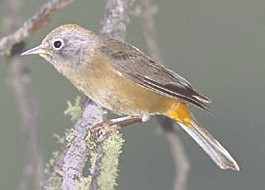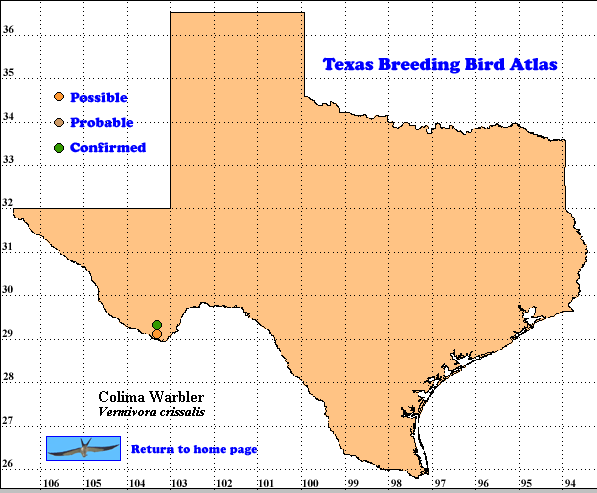The Colima Warbler was first collected in the Mexican state of Colima on its wintering grounds in 1889. Study by van Tyne, Wauer and Marshall and coworkers have produced most of our knowledge of this warbler, probably the least know of any warbler in the United States. The Colima is larger than Lucy’s (V. luciae) and Virginia’s (V. virginiae) warblers, has a generally gray-brown appearance with olive-yellow rump and upper-tail coverts and ochre-yellow under-tail coverts (Howell and Webb 1995, Beason and Wauer 1998).
DISTRIBUTION. During the 1987-1992 field work seasons of the TBBA project, observers found breeding evidence for the Colima Warbler in latilong 29103, a confirmed record in quad C3 and possible breeding in B3. Both these quads are in the Chisos Mountains where nesting was first discovered in 1932. This is apparently the northern limit of the breeding range which extends southeast in the Sierra Madre Oriental through Coahuila and Nuevo Leon to San Luis Potosi. The species winters from Sinaloa to Oaxaca in southwest Mexico (Howell and Webb 1995, Beason and Wauer 1998,, Lockwood and Freeman 2004).
SEASONAL OCCURRENCE. These warblers begin arriving in the Chisos Mountains by mid-March and all are on territories by late May. Territorial singing begins there in early to mid-April, eggs have been found in nests from May 12-30 and nestlings from May 25 to July 19. Colima Warblers have all left the Chisos Mountains by early September (Oberholser 1974, Beason and Wauer 1998, Lockwood and Freeman 2004).
BREEDING HABITAT. In the Chisos Mountains Colima Warblers breed between about 1500 and 2300 m (5000-7500 ft) in mixtures of oaks, Mexican pinyon, juniper and Arizona cypress (Oberholser 1974, Beason and Wauer 1998, Lockwood and Freeman 2004).
The female builds the nest in a depression in the ground or under a grass clump where the nest is shaded by grass, tree roots, rocks, or leaves. The nest is built of an initial mass of dead or decaying leaves. On this she forms a cup of grass, moss, bark and leaves and lines the cup with fine grass or animal hair, The inside diameter of the cup is 5-5.7 cm (2-2.3 in) and depth 4-4.5 cm (1.6-1.8 in; Beason and Wauer 1998).
The female usually lays 4 creamy white eggs with spotting and splotching in a band around the large end. The female incubates the clutch for about 12 days and the young birds leave the nest about 11 days after hatching. Second broods are occasionally started after a successful first nesting (Beason and Wauer 1998). .
STATUS. Colima Warbler is an uncommon and extremely localized summer resident in the Chisos Mountains (Lockwood and Freeman 2004). Censuses at 10 locations in the Chisos Mountains between 1967 and 1996 (n = 9 years) produced population totals ranging from 42 to 83. In 1996 a second population of 26 pairs was discovered in an area not previously occupied (Beason and Wauer 1998). Since Colima Warblers were first found in the Chisos Mountains in 1928 and the first nest in 1932 (van Tyne 1936) the persistence of this population is a hopeful sign for the future, barring any catastrophic fire in the area. Text by Robert C. Tweit (2007)
Howell, S. N. G. and S. Webb. 1995. A guide to the birds of Mexico and northern Central America. Oxford University Press, New York.
van Tyne, J. 1936. The discovery of the nest of the Colima Warbler (Vermivora crissalis). Misc. Publ. Mus. Zool., Univ. Mich. 33: 5-11.

